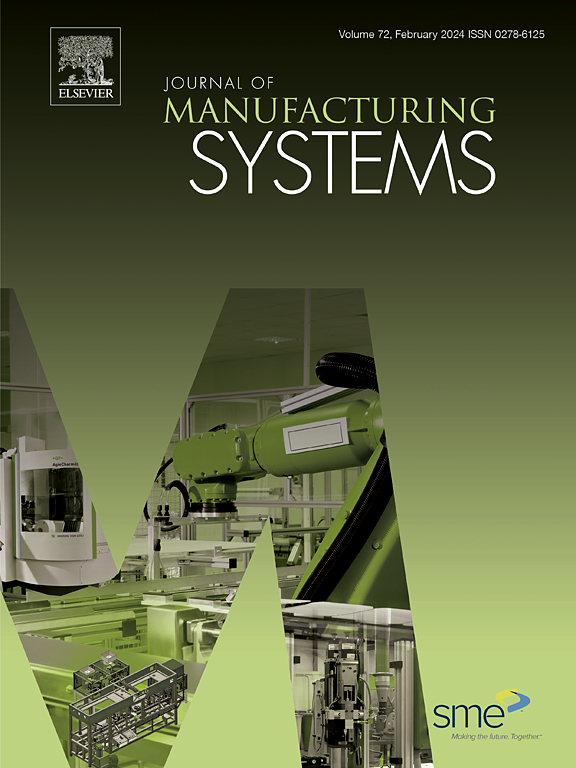Environmental impact of powder production for additive manufacturing: Carbon footprint and cumulative energy demand of gas atomization
IF 14.2
1区 工程技术
Q1 ENGINEERING, INDUSTRIAL
引用次数: 0
Abstract
The production of metal powder required for certain metal additive manufacturing processes has a significant environmental impact on the process chain. In particular, there is a lack of energy- and resource-related data on the environmental impact of industrial powder production and in-depth analysis of individual process steps. This study aims to provide a reliable life cycle inventory and, based on this, to determine the global warming potential (GWP) and cumulative energy demand (CED) resulting from the industrial production of melt atomized metal powders for additive manufacturing using gas atomization within the framework of a life cycle assessment (LCA). In this LCA, considering an average electricity mix at a production site in Germany, the GWP for closed-coupled atomization ranged from 4.61 kg CO2-eq./kg to 16.71 kg CO2-eq./kg. The results are slightly lower than those of free-fall atomization with a GWP between 5.58 kg CO2-eq./kg and 24.81 kg CO2-eq./kg. The need for inert gas is a major contributor to the environmental impact. If argon is used as an atomizing gas instead of nitrogen, the environmental impact increases, since argon has a GWP and CED approximately six times higher than nitrogen. Preheating the inert gas reduces the requirement and thus also the resulting environmental impact. This study provides a crucial basis for assessing the environmental impact of powder metal additive manufacturing processes and, enabling environmentally friendly process and product design. In addition, effective strategies to reduce the environmental impact of gas atomization can be identified based.
增材制造粉末生产的环境影响:气体雾化的碳足迹和累积能源需求
某些金属增材制造工艺所需的金属粉末的生产对工艺链的环境影响很大。特别是,缺乏关于工业粉末生产对环境影响的能源和资源相关数据以及对单个工艺步骤的深入分析。本研究旨在提供可靠的生命周期清单,并以此为基础,在生命周期评估(LCA)的框架内,确定用于增材制造的熔融雾化金属粉末的工业生产所产生的全球变暖潜势(GWP)和累积能源需求(CED)。在此LCA中,考虑到德国生产基地的平均电力组合,封闭耦合雾化的GWP范围为4.61 kg CO2-eq。/kg至16.71 kg co2当量/kg。结果略低于自由落体雾化,GWP在5.58 kg CO2-eq之间。/kg和24.81 kg co2当量/kg。对惰性气体的需求是造成环境影响的一个主要因素。如果使用氩气代替氮气作为雾化气体,则会增加对环境的影响,因为氩气的GWP和CED大约是氮气的六倍。预热惰性气体降低了要求,从而也减少了对环境的影响。该研究为评估粉末金属增材制造工艺对环境的影响以及实现环保工艺和产品设计提供了重要的基础。此外,还可以确定减少气体雾化对环境影响的有效策略。
本文章由计算机程序翻译,如有差异,请以英文原文为准。
求助全文
约1分钟内获得全文
求助全文
来源期刊

Journal of Manufacturing Systems
工程技术-工程:工业
CiteScore
23.30
自引率
13.20%
发文量
216
审稿时长
25 days
期刊介绍:
The Journal of Manufacturing Systems is dedicated to showcasing cutting-edge fundamental and applied research in manufacturing at the systems level. Encompassing products, equipment, people, information, control, and support functions, manufacturing systems play a pivotal role in the economical and competitive development, production, delivery, and total lifecycle of products, meeting market and societal needs.
With a commitment to publishing archival scholarly literature, the journal strives to advance the state of the art in manufacturing systems and foster innovation in crafting efficient, robust, and sustainable manufacturing systems. The focus extends from equipment-level considerations to the broader scope of the extended enterprise. The Journal welcomes research addressing challenges across various scales, including nano, micro, and macro-scale manufacturing, and spanning diverse sectors such as aerospace, automotive, energy, and medical device manufacturing.
 求助内容:
求助内容: 应助结果提醒方式:
应助结果提醒方式:


